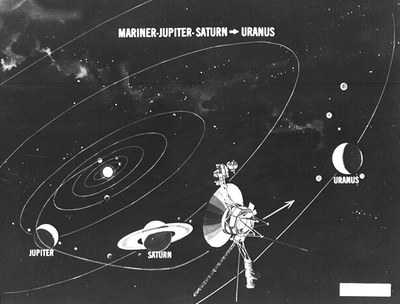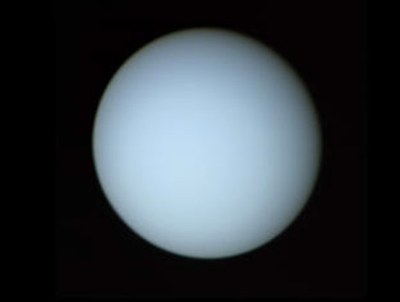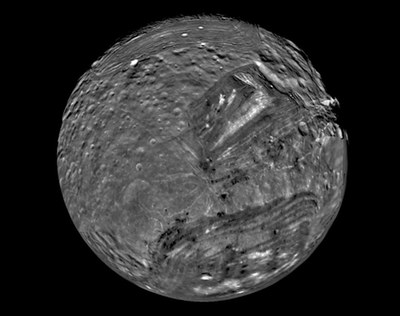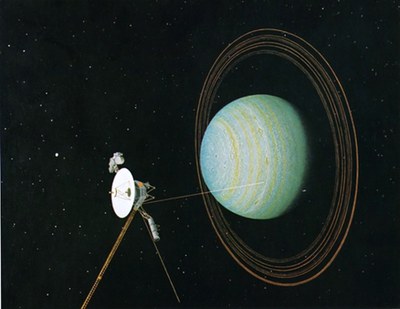The Grand Tour: Uranusby Andrew J. LePage
|
| In the end, NASA’s plans for the Grand Tour proved to be too ambitious and far too expensive with an estimated price tag of $900 million (almost $5 billion today). |
But in 1965, Gary Flandro, then a NASA summer intern, discovered that as a result of a rare alignment of the outer planets that occurs only once every 176 years, it would be possible to send a probe to Jupiter in the late 1970s and then have it flyby successively more distant planets for a fast reconnaissance of all the outer planets. While the largest rockets available were just capable of sending a respectable payload directly to Jupiter, this giant planet’s gravity would provide the extra boost needed to reach all of the planets beyond with flight times of just years.
In 1969 NASA formally began design of what they called the Grand Tour mission. They envisioned building a set of highly advanced, nuclear-powered probes capable of enduring a decade-long mission—many times longer than had been demonstrated with any earlier spacecraft. In one of the many options considered, a pair of Grand Tour spacecraft would be launched in August 1977. They would reach Jupiter around January 1979, Saturn about August 1980, and finally distant Pluto (still considered a planet then) in December 1985. A second pair of probes would depart the Earth in November 1979 and arrive at Jupiter around March 1981. Jupiter would then slingshot the spacecraft to Uranus in February 1985 and Neptune in February 1988 to complete the Grand Tour.
In the end, NASA’s plans for the Grand Tour proved to be too ambitious and far too expensive with an estimated price tag of $900 million (almost $5 billion today). In 1972 NASA scaled back the mission to have a single pair of Mariner-class spacecraft take advantage of the 1977 launch window to Jupiter and Saturn. Originally designated Mariner Jupiter-Saturn 1977 (MJS 77), this more modest mission was managed by the Jet Propulsion Laboratory (JPL) and could be completed with a flight time of four years at an estimated cost of $250 million. By the time of their launch in the summer of 1977, the MJS 77 spacecraft were renamed Voyager.
In order to preserve as much of the original Grand Tour as possible, NASA also began studies for a Mariner Jupiter-Uranus 1979 (MJU 79) mission. MJU 79 would use modified Voyager spacecraft equipped with upgraded systems and instruments. Later, more ambitious versions of this proposal even included an entry probe. In the end, the MJU 79 proposal was not approved in part because of NASA’s ever-tightening budgets in the post-Apollo era.
Even after the cancellation MJU 79, NASA still had a chance of getting a mission to Uranus, albeit a very slim chance. It was possible to have one of the Voyagers continue on to Uranus after its encounter with Saturn, assuming that it had enough propellant left and its vital systems survived that long. A major driver for getting to Uranus was Saturn’s largest moon, Titan (see “The Mysteries of Titan”, The Space Review, November 8, 2010). Mysterious Titan was a prime target for exploration and a close encounter by one of the Voyagers was a mission requirement. Unfortunately, there were no trajectories at that time that allowed a close pass by Titan while preserving the option to continue on to Uranus. In the end it was decided that if the first Voyager spacecraft successfully completed its objectives at Titan in November 1980, the second spacecraft would be directed to follow a trajectory past Saturn in August 1981 that preserved the option to flyby Uranus in late January of 1986. But if the first Voyager failed, the second would instead fly an alternative course that allowed it to flyby Titan with no chance of any subsequent planetary encounters.
 A NASA rendering released around 1976 of a Mariner Jupiter-Saturn 1977 (later called Voyager) spacecraft exercising the Uranus option. (credit: NASA) |
The Voyagers
Even though they were less sophisticated than the originally proposed Grand Tour spacecraft, the Voyagers were still the most advanced interplanetary spacecraft of their day. The pair of identical probes had a mass of 825 kilograms (1,820 pounds) each at launch. Their appearance was dominated by a large white dish antenna with a diameter of 3.7 meters (12 feet) that was used to communicate with the Earth. This was mounted on top of the ten-sided main body of Voyager, which was derived from earlier Mariner spacecraft that had explored the inner planets of the Solar System.
| While its computers are primitive by today’s standards, they gave the Voyagers much more flexibility than any earlier planetary spacecraft. |
All of the spacecraft’s electronic equipment was housed in the various compartments of the main body, including three pairs of redundant reprogrammable computers that controlled all the functions of the spacecraft and its instruments. The most important computer system was the Command Control Subsystem (CCS), which was the heart of Voyager’s control system. Next was the Attitude and Articulation Control Subsystem (AACS), which controlled propulsion, attitude control, and instrument pointing. Finally there was the Flight Data System (FDS), which controlled the instruments, stored data, and prepared all the science and engineering data for transmission back to Earth. While these computers are primitive by today’s standards, they gave the Voyagers much more flexibility than any earlier planetary spacecraft.
Voyager sported a number of appendages. One was a boom carrying a set of three radioisotope thermoelectric generators (RTGs) that supplied Voyager with up to 390 watts of electricity. Opposite the RTGs was another boom with the pointable Science Scan Platform mounted on the end. Various boresighted sensors for infrared radiation, polarimetry, ultraviolet spectroscopy, as well as wide- and narrow-angle cameras were fitted to this platform. Instruments for measuring the electromagnetic fields, particles, and the plasma environment were fixed to the body of the spacecraft. The other appendages on Voyager included a slender 13-meter (43-foot) long boom carrying sensitive magnetometers and a pair of 10-meter (33-foot) whip antennas shared by the plasma wave and planetary radio astronomy instruments.
The Voyagers were launched using the Titan IIIE - Centaur D-1T, which was the most powerful American launch vehicle available after the retirement of the Saturn rockets at the end of the Apollo program. To give Voyager the extra kick needed to get to Jupiter, a Thiokol TE 364-4 solid rocket motor, similar to the type used in the third stage of the Delta as well as other launch vehicles of the day, topped off the launch vehicle.
 An image of Uranus acquired by Voyager 2 during its approach in January 1986. (credit: NASA/JPL) |
The mission starts
After dealing with a host of last minute issues, Voyager 2 was successfully launched on August 20, 1977. But minor problems would continue to crop up after lift off. About an hour after launch, the boom that carried the Science Scan Platform was suppose to extend but the signal was never received that it had fully deployed. After several attempts to lock the boom in place apparently failed, engineers at JPL suspected the problem was not with the boom but the extension sensor. Test images acquired by the cameras of the spacecraft itself confirmed that the science boom had fully extended to within a fraction of a degree.
Voyager 1 was finally launched on September 5 after a series delays to deal with its own last minute problems. Like its sister, Voyager 1 experienced a number of growing pains after leaving the Earth. Ultimately the problems were resolved and the probes’ computers were reprogrammed as needed to optimize spacecraft performance. In particular, changes to AACS programs and the probes’ cruise attitude led to a significant reduction in hydrazine consumption for attitude control. Combined with near optimum launch dates, excellent launch vehicle performance and accurate navigation, Voyager 2 would now have more than sufficient propellant reserves to reach Uranus.
| But with only one balky receiver and no backup, controllers were at risk of losing contact with Voyager 2. The prospects for a mission to Uranus dimmed significantly. |
By far the most serious crises experienced by Voyager 2 started on April 5, 1978, when engineers discovered that the primary receiver had failed. As programmed, the CCS had switched to the backup receiver when the problem was detected, but the backup was also found to be faulty. The backup receiver’s tracking loop capacitor was malfunctioning and the receiver was unable to lock onto the Doppler-shifted transmissions from controllers on Earth. When controllers switched back to the primary receiver, it experienced a power surge within 30 minutes and blew a fuse, permanently disabling the receiver.
Over the course of the next week engineers worked feverishly to address the problem. On April 13 Voyager 2 was finally contacted by ground controllers and slowly regained regular contact with the receding probe. But with only one balky receiver and no backup, controllers were at risk of losing contact with Voyager 2. As insurance, on June 23, 1978 Voyager 2 was programmed for a bare bones backup mission to automatically flyby Saturn. By October 12 similar instructions were uploaded for a minimum encounter at Jupiter as a backup. The prospects for a mission to Uranus dimmed significantly.
But as the months and years unfolded, the partially deaf backup receiver continued to function and engineers slowly learned how to predict what frequency to transmit from Earth so that the faulty receiver could accept commands. In the mean time, Voyager 1 made its closest pass by Jupiter on March 5, 1979, with Voyager 2 following on July 9. Both spacecraft met their objectives and returned a treasure trove of images and other scientific data about Jupiter and its system of moons.
After leaving the Jovian system, both Voyagers pushed on to Saturn, with Voyager 1 reaching its distant target on November 13, 1980. After Voyager 1 successfully achieved all its objectives during its close encounter with Titan and Saturn, Voyager 2 was now free to exercise the option to continue on to Uranus. And with the continued good performance of Voyager 2 despite the loss of its primary receiver, Voyager program scientists and engineers even began to examine the option of having Voyager 2 flyby Neptune in August 1989 after its Uranus encounter. If Voyager 2 could survive the dozen years needed to reach this remote world, four out of the five original Grand Tour targets would have been reached by the less sophisticated Voyager 2.
On August 25, 1981, Voyager 2 hit its target 101,000 kilometers (63,000 miles) from Saturn to slingshot on to Uranus. But 100 minutes after closest approach, the Science Scan Platform jammed. Within a couple days, engineers at JPL were able to free the platform but much of the post-flyby data was already lost. In time the problem was traced to excessive use of high slew rates in azimuth that forced lubrication from the actuator’s gears. It was felt that restricting the number of slews and the slew rate of the platform would prevent a recurrence of the problem. If the azimuth actuator seized again, a technique to free it using thermal cycling was developed. But just in case the platform permanently froze in azimuth, the entire spacecraft could be rolled to point the instruments while still using the platform’s elevation actuator. It was estimated that Voyager 2 had enough propellant for 150 such roll maneuvers at Uranus but the Neptune option would be in danger.
 This mosaic of Miranda was constructed from images acquired by Voyager 2. (credit: NASA/JPL/USGS) |
On to Uranus
During Voyager’s quiet four and a half year cruise from Saturn to Uranus, program scientists and engineers were busy back on Earth preparing for the challenging encounter with Uranus. Because of its greater distance, the solar illumination at Uranus is only one quarter of that at Saturn. The greater distance also meant that Voyager’s transmissions to Earth would also be that much weaker. As a result, much less data could be transmitted from Uranus than either Jupiter or Saturn.
In order to improve the data transmission rate, NASA upgraded its Deep Space Network (DSN) stations. The most aggressive improvements were made to the DSN station near Canberra, Australia, in part because it would have the best view of Uranus from its vantage in the southern hemisphere. The 64-meter (210-foot) antenna usually used for communications with Voyager was electronically linked with two 34-meter (112-foot) antennas at the complex as well as the Parkes 64-meter radio astronomy antenna located 320 kilometers (200 miles) away. The 64-meter antennas at the DSN sites in Goldstone, California, and near Madrid, Spain, were arrayed with a 34-meter antenna at each site to improve reception from Uranus. Voyager 2 would now be capable of transmitting data at a rate as high as 21.6 kilobits per second from Uranus, or just half the rate used at Saturn.
| With no serious plans currently being considered to take advantage of the next Jupiter-Uranus alignment at the end of this decade, it will likely be at least another quarter of a century before the next mission to Uranus might be launched. |
Because of the flexibility afforded by Voyager’s computers, engineers at JPL were able to upgrade some of the spacecraft’s capabilities remotely. The unused backup FDS on Voyager 2 was reprogrammed to compress raw imaging data. Instead of transmitting the full 8-bit brightness value for each image pixel, only the full brightness value of the first pixel in each row was transmitted, with just the brightness differences saved for the rest of the pixels in the row. This compression technique resulted in an average of only 3 bits per pixel. To protect the compressed data from bit errors during transmission, a Reed-Solomon encoder that was carried on board was used on the compressed images as well as the other science data. Previously images were unencoded and non-imaging science data were passed through one of a redundant pair of Golay encoders also carried by the Voyagers. These steps required significantly more work back on Earth to decode the data and reconstruct the images but they allowed up to 200 images to be transmitted each day.
Because of the dim illumination and dark targets expected at Uranus, the exposure times needed to acquire usable images was much longer than at Saturn. The AACS was reprogrammed to steady Voyager more effectively, resulting in a drift rate of only half an arc minute per minute, or less than a quarter of that experienced at Saturn. While a steady platform was needed for distant observations, images of closer targets would smear during long exposures. The AACS was programmed with a new motion compensation technique that accurately slewed the spacecraft during observations at rates as high as two degrees per minute to compensate for the relative movement between Voyager 2 and a close target.
During its encounter, Voyager 2 viewed Uranus nearly pole on with its rings (which were discovered only months before launch in 1977) and the orbits of its five moons then known looking like a cosmic bulls eye. As a result, only the southern half of Uranus and its moons would be lit. Unlike the situation at Jupiter and Saturn where the close encounters with the planet and various moons took place over the course of a day or more, the close encounters at Uranus would take place in rapid succession over a just a few hours.
In order to deflect its trajectory towards Neptune, Voyager was directed towards a specific aim point 81,600 kilometers (50,700 miles) above the cloud tops of Uranus. The timing of the close encounter events was chosen so that they could be observed from the DSN station in Australia. As luck would have it, this allowed Voyager to pass only 29,000 kilometers (18,000 miles) from the smallest and innermost Uranian moon then known, Miranda. This was the closest Voyager 2 passed by any planet or moon up to this point in its mission.
In case the faulty backup receiver failed before the encounter, Voyager 2 was programmed to automatically execute a barebones backup mission that promised to return at least some data from Uranus. Other backup encounter sequences were also prepared for transmission to Voyager 2 in case of a failure in one of the computers or if the scan platform seized again, as well as a host of other contingencies.
On November 4, 1985, Voyager 2 started its observatory sequence where it created a series of time lapse movies of Uranus and its surroundings. In December Voyager spotted its first new moon—eventually called Puck—inside the orbit of Miranda. On January 10, 1986, Voyager 2 started its faster-paced far encounter sequence. As Voyager moved closer, it became apparent that Uranus had a blander appearance than was expected. Only subtle variations in color and extremely faint cloud features were detectable even after extensive image processing. On January 18 Voyager 2 started returning images that were heavily streaked. The problem was quickly traced to a bad element in the FDS used for image compression. New instructions were uploaded to avoid the faulty element and normal images were received again starting January 21—just three days before closest approach.
Around 10.6 hours before closest approach, Voyager 2 entered Uranus’ magnetosphere, which was first detected remotely via its radio emissions just five days earlier. As Voyager 2 neared Uranus, it continued observations not only of the planet but its five larger moons, which displayed a surprising range of geologic activity. About an hour before closest approach, Voyager 2 flew by Miranda. The image compensation technique worked perfectly and the images returned revealed a rich variety of features across the face of the tiny moon. A total of ten additional moons inside the orbit of Miranda were spotted during approach.
On January 24, 1986, at 17:58:24 UT, Voyager 2 made its closest approach to Uranus and its trajectory was deflected towards Neptune as intended. Voyager continued to make observations for the next month as Uranus receded. In the end, almost 7,000 images and a mass of other scientific data were returned about Uranus, its moons, and its rings, that are still being studied. To this day Voyager 2 is the only spacecraft to have visited Uranus. With no serious plans currently being considered to take advantage of the next Jupiter-Uranus alignment at the end of this decade, it will likely be at least another quarter of a century before the next mission to Uranus might be launched.
Bibliography
Ellis D. Miner, “Voyager 2 and Uranus”, Sky & Telescope, Vol. 70, No. 5, pp 420–423, November 1985.
David Morrison and Jane Samz, Voyages to Jupiter (SP-439), NASA, 1980.
David Morrison, Voyages to Saturn (SP-451), NASA, 1982.
Bruce Murray, Journey in Space: The First Thirty Years of Space Exploration, W.W. Norton & Co., 1989.
Bruce A. Smith, “NASA Reconfigures Voyager 2, Ground Stations for Uranus Flyby”, Aviation Week & Space Technology, Vol. 122, No. 20, pp 65–68, May 20, 1985.
E.C. Stone and E.D. Miner, “The Voyager 2 Encounter with the Uranian System”, Science, Vol. 233, No. 4759, pp 39–43, July 4, 1986.
Voyager to Jupiter and Saturn (SP-420), NASA, 1977.
“Voyager 1986 Press Kit”, Release No. 85-176, NASA, January 1986.
“Voyager 2 Managers Resolve Imagery Problem Before Uranus Encounter”, Aviation Week & Space Technology, Vol. 124, No. 4, pp 24-25, January 27, 1986.
